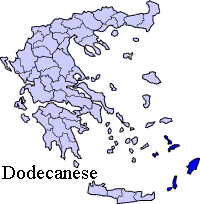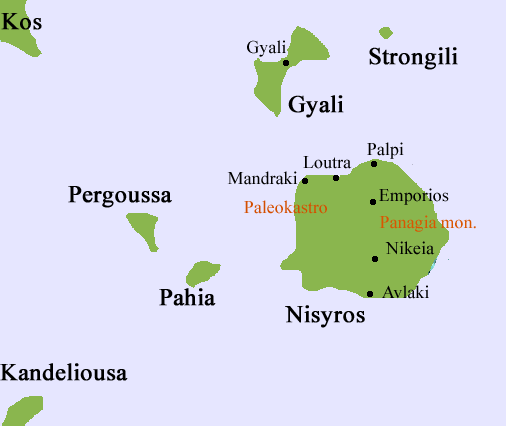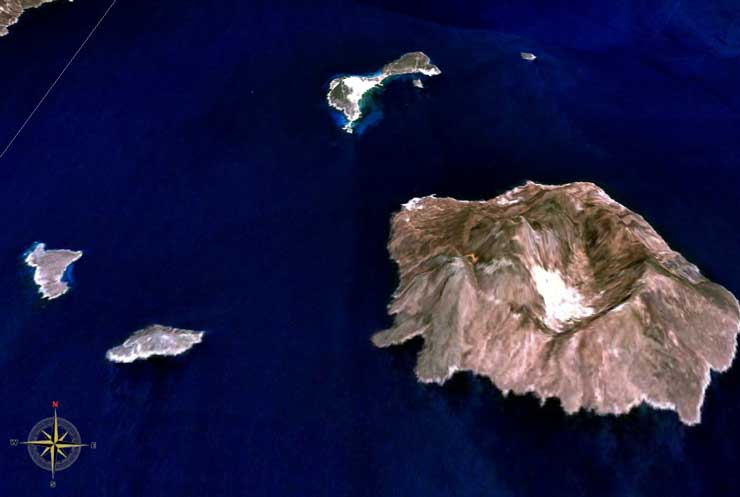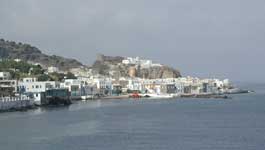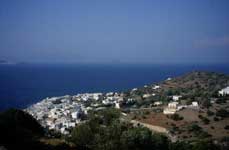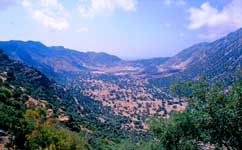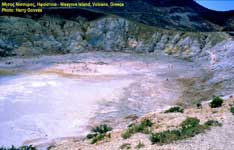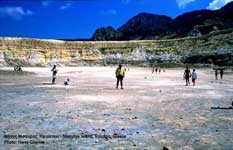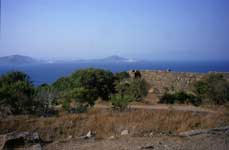|
|
Periphery: South Aegean
Satellite image of Nisyros island, an active volcano Nisyros (Greek: Νίσυρος; also transliterated Nissiros) is a volcanic Greek island located in the Aegean Sea. It is part of the Dodecanese group of islands, and lies between Kos and Tilos. Its shape is approximately round, with a diameter about 8 km, and its area is 41.6 km². Several other islets are found in the vicinity of Nisyros, the largest of which is Gyali. The island has a mountainous interior and in its center several craters are found. Its coasts are generally rocky or pebbled, but there are also a few sandy beaches. The island is reachable by ship from Pireaus and Kos. There is also a heliport. A view of Mandraki. In the background, the monastery of Panagia Spiliani and the medieval castle The volcano is currently active (not erupting), and fumaroles are found at the craters. The latest eruptive activity was a steam explosion in 1888, after small ash eruptions in 1871 and 1873 and earthquakes are not infrequent. A period of seismic unrest in 1996-1997 led an international team of scientist to initiate monitoring of the volcanic unrest in the European-Union sponsored Geowarn project. The entire volcanic complex includes the seafloor between Nisyros and Kos, the island of Gyali (Yali), and a part of Kos island
Poseidon and Polybotes, Louvre F226 Polybotes was chased through the sea by Poseidon and came to Cos; and Poseidon, breaking off that piece of the island which is called Nisyrum, threw it on him., Apollodorus, Library and Epitome 1.6.2 According to Greek mythology, the island was formed when Poseidon cut a part of Kos and threw it on the giant Polyvotis (Polybotes) to stop him from escaping. The ancient name of the Nisyros was Porphyris. It was celebrated in antiquity for its warm springs, wine, and mill-stones. Its capital, stood on the NW extremity of the island, where considerable ruins of its Acropolis remain. Its first inhabitants are said to have been Carians ; but already in the heroic age it had received a Dorian population, like other islands near it, with which it is mentioned by Homer as sending troops to the Greeks. It received other Dorian settlements in the historical age. At the time of the Persian war, it belonged to the Carian Queen Artemisia ; it next became a tributary ally of Athens : though transferred to the Spartan alliance by the issue of the Peloponnesian war, it was recovered for Athens by the victory at Cnidos, B.C. 394. After the defeat of Antiochus the Great by the Romans, it was assigned to Rhodes ; and, with the rest of the Rhodian Republic, was united to the Roman Empire about B.C 70. The main town and port of the island is Mandraki. Other villages are Paloi, Nikeia and Emporio. According to a 2001 census, the resident population is 948, although in summer it is augmented by many tourists as well as expatriate Nisyrians who visit the island for their vacations. Tourism is not so heavily developed as in other Greek islands. On Gyali there are deposits of perlite and pumice which provide much of the wealth of the island. The island used to be self-sufficient, and many crops were grown on its terraced slopes. Today, though, they are cultivated on a smaller scale.
Nisyros, Traditional Fashion There is a health spa with sulphurous waters that used to be world-famous in the first decades of the 20th century. A traditional product of Nisyros is soumada, a non-alcoholic almond-flavoured drink. The patron saint of the island is Saint Nikitas. Many Orthodox Christian churches are found on the island, as well as four monasteries which are not inhabited by monks today, although various celebrations take place in them. The largest monastery is the one of Panagia Spiliani (Blessed Virgin Mary of the cave) at Mandraki. It is built beside the medieval castle erected by the Knights Hospitaller who conquered the island on 1315. Ancient walls, dating from the 5th century BC, part of the acropolis of the island, are found near Mandraki. Division of the municipality
Hotels & Holidays in Greece: Dodecannese islands: Nisyros Island Literature
 |
|
||||||||||||||||||
